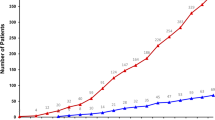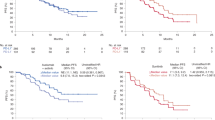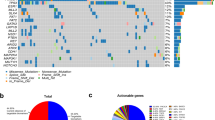Summary
Purpose Improved prognostic accuracy for treatment response and a wider understanding of drug effects in humans are crucial for enhancing the utility of sorafenib and other promising targeted therapies. We developed a strategy of global genomic investigation of sequential tumor biopsy samples at baseline and 21 days post treatment, and applied this approach in a phase I study of sorafenib plus dacarbazine in patients with solid tumors. The objective of this study was also to validate functional parameters of DCE-US as surrogate markers to predict earlier response. Experimental design Patients received 21-day cycles of oral sorafenib, 400 mg twice daily and dacarbazine, 1,000 mg/m2 in a 1-h intravenous infusion on day 1. Efficacy was assessed using response evaluation criteria in solid tumors. Sequential biopsy samples (baseline and day 21) were obtained from the same tumor. Changes from baseline in global gene expression (GE) measured by genomic microarrays and in tumor vascularity at baseline, D8, D21, D 42 and every 2 cycles using dynamic contrast-enhanced ultrasonography (DCE-US) were analyzed for patients with and without a clinical response to treatment at 3 months. Results Among 23 patients evaluable for treatment efficacy, 17 were eligible for gene expression and DCE-US analyses. One patient achieved a partial response; 14 exhibited stable disease. Ten patients were defined as exhibiting stable disease (SD) and 7, progressive disease (PD) at 3 months. Genomic analyses identified a 237-gene signature that distinguished SD from PD at 3 months. Of note, CDK4 overexpression and PDGFR downregulation were associated with PD. Functional parameters of DCE-US representing the blood volume at baseline, day 8, and day 21 were correlated with disease progression at 3 months. Conclusions This novel approach of sequential investigations in a phase I trial was feasible, detecting early changes in gene expression and tumor vascularity evaluated using DCE-US that may be predictive of clinical outcome.






Similar content being viewed by others
References
Roberts PJ, Der CJ (2007) Targeting the Raf-MEK-ERK mitogen-activated protein kinase cascade for the treatment of cancer. Oncogene 26:3291–3310
Davies H, Bignell GR, Cox C, Stephens P, Edkins S, Clegg S et al (2002) Mutations of the BRAF gene in human cancer. Nature 417:949–954
Wilhelm SM, Adnane L, Newell P, Villanueva A, Llovet JM, Lynch M (2008) Preclinical overview of sorafenib, a multikinase inhibitor that targets both Raf and VEGF and PDGF receptor tyrosine kinase signalling. Mol Cancer Ther 7:3129–3140
Sharma A, Trivedi NR, Zimmerman MA, Tuveson DA, Smith CD, Robertson GP (2005) Mutant V599EB-Raf regulates growth and vascular development of malignant melanoma tumors. Cancer Res 65:2412–2421
Lu X, Tang X, Guo W, Ren T, Zhao H (2010) Sorafenib induces growth inhibition and apoptosis of human chondrosarcoma cells by blocking the RAF/ERK/MEK pathway. Surg Oncol 102:821–826
Katz SI, Zhou L, Chao G, Smith CD, Ferrara T, Wang W et al (2009) Sorafenib inhibits ERK1/2 and MCL-1(L) phosphorylation levels resulting in caspase-independent cell death in malignant pleural mesothelioma. Cancer Biol Ther 8:2406–2416
Eisen T, Ahmad T, Flaherty KT, Gore M, Kaye S, Marais R et al (2006) Sorafenib in advanced melanoma: a phase II randomised discontinuation trial analysis. Br J Cancer 95:581–586
von Mehren M, Rankin C, Goldblum JR, Demetri GD, Bramwell V, Ryan CW et al (2012) Phase 2 Southwest Oncology Group-directed intergroup trial (S0505) of sorafenib in advanced soft tissue sarcomas. Cancer 118:770–776
Dubey S, Jänne PA, Krug L, Pang H, Wang X, Heinze R et al (2010) A phase II study of sorafenib in malignant mesothelioma: results of Cancer and Leukemia Group B 30307. J Thorac Oncol 5:1655–1661
Eggermont AM, Kirkwood JM (2004) Re-evaluating the role of dacarbazine in metastatic melanoma: what have we learned in 30 years? Eur J Cancer 40:1825–1836
Zucali PA, Bertuzzi A, Parra HJ, Campagnoli E, Quagliuolo V, Santoro A (2008) The “old drug” dacarbazine as a second/third line chemotherapy in advanced soft tissue sarcomas. Invest New Drugs 26:175–181
Eisen T, Ahmad T, Gore ME et al (2005) Phase I trial of BAY 43–9006 (sorafenib) combined with dacarbazine (DTIC) in metastatic melanoma patients [2005 ASCO meeting abstract]. J Clin Oncol 23(Jun 1 suppl):7508
Eisen T, Marais R, Affolter A, Lorigan P, Robert C, Corrie P et al (2011) Sorafenib and dacarbazine as first-line therapy for advanced melanoma: phase I and open-label phase II studies. Br J Cancer 105:353–359
Brendel E, Ludwig M, Lathia C, Robert C, Ropert S, Soria JC, Armand JP (2011) Pharmacokinetic results of a phase I trial of sorafenib in combination with dacarbazine in patients with advanced solid tumors. Cancer Chemother Pharmacol 68:53–61
Lassau N, Cosgrove D, Armand JP (2012) Early evaluation of targeted drugs using dynamic contrast-enhanced ultrasonography for personalized medicine. Future Oncol 8:1215–1258
Piscaglia F, Nolsøe C, Dietrich CF, Cosgrove DO, Gilja OH, Bachmann Nielsen M et al (2012) he EFSUMB Guidelines and Recommendations on the Clinical Practice of Contrast Enhanced Ultrasound (CEUS): update 2011 on non-hepatic applications. Ultraschall Med 33:33–59
Claudon M, Dietrich CF, Choi BI, Cosgrove DO, Kudo M, Nolsøe CP, et al (2013) Guidelines and Good Clinical Practice Recommendations for Contrast Enhanced Ultrasound (CEUS) in the Liver-Update 2012: A WFUMB-EFSUMB Initiative in Cooperation With Representatives of AFSUMB, AIUM, ASUM, FLAUS and ICUS. Ultrasound Med Biol 39(2):187-210
Gentleman RC, Carey VJ, Bates DM, Bolstad B, Dettling M, Dudoit S, Ellis B, Gautier L, Ge Y, Gentry J, Hornik K, Hothorn T, Huber W, Iacus S, Irizarry R, Leisch F, Li C, Maechler M, Rossini AJ, Sawitzki G, Smith C, Smyth G, Tierney L, Yang JY, Zhang J (2004) Genome biology, bioconductor: open software development for computational biology and bioinformatics. Genome Biol 5:R80
Kauffmann A, Gentleman R, Huber W (2009) arrayQualityMetrics—a bioconductor package for quality assessment of microarray data. Bioinformatics 25:415–416
Lassau N, Chapotot L, Benatsou B, Vilgrain V, Kind M, Lacroix J et al (2012) Standardization of dynamic contrast-enhanced ultrasound for the evaluation of antiangiogenic therapies: the French multicenter support for innovative and expensive techniques study. Invest Radiol 47:711–716
Dietrich CF, Averkiou MA, Correas JM, Lassau N, Leen E, Piscaglia F (2012) An EFSUMB introduction into Dynamic Contrast-Enhanced Ultrasound (DCE-US) for quantification of tumour perfusion. Ultraschall Med 33:344–351
Hensley ML, Sill MW, Scribner DR Jr, Brown J, Debernardo RL, Hartenbach EM et al (2009) Sunitinib malate in the treatment of recurrent or persistent uterine leiomyosarcoma: a Gynecologic Oncology Group phase II study. Gynecol Oncol 115:460–465
McMeekin DS, Sill MW, Darcy KM, Stearns-Kurosawa DJ, Webster K, Waggoner S et al (2007) A phase II trial of thalidomide in patients with refractory leiomyosarcoma of the uterus and correlation with biomarkers of angiogenesis: a gynecologic oncology group study. Gynecol Oncol 106:596–603
Mackay HJ, Buckanovich RJ, Hirte H, Correa R, Hoskins P, Biagi J et al (2012) A phase II study single agent of aflibercept (VEGF Trap) in patients with recurrent or metastatic gynecologic carcinosarcomas and uterine leiomyosarcoma. A trial of the Princess Margaret Hospital, Chicago and California Cancer Phase II Consortia. Gynecol Oncol 125:136–140
Michiels S, Koscielny S, Hill C (2005) Prediction of cancer outcome with microarrays: a multiple random validation strategy. Lancet 365:488–492
Koscielny S (2008) Critical review of microarray-based prognostic tests and trials in breast cancer. Curr Opin Obstet Gynecol 20:47–50
Lassau N, Chami L, Koscielny S, Chebil M, Massard C, Benatsou B et al (2012) Quantitative functional imaging by dynamic contrast enhanced ultrasonography (DCE-US) in GIST patients treated with masatinib. Invest New Drugs 30:765–771
Lassau N, Koscielny S, Albiges L, Chami L, Benatsou B, Chebil M et al (2010) Metastatic renal cell carcinoma treated with sunitinib: early evaluation of treatment response using dynamic contrast-enhanced ultrasonography. Clin Cancer Res 16:1216–1225
Lassau N, Koscielny S, Chami L, Chebil M, Benatsou B, Roche A et al (2011) Advanced hepatocellular carcinoma: early evaluation of response to bevacizumab therapy at dynamic contrast-enhanced US with quantification—preliminary results. Radiology 258:291–300
Acknowledgments
We would like to acknowledge Serge Koscielny for his contributions to the conception of the study. We also acknowledge Meenakshi Subramanian, PhD, and Ann Garvey, PhD, Evidence Scientific Solutions, and Robert Marlowe, BA, for assistance with manuscript writing, which was supported by Bayer HealthCare Pharmaceuticals and Onyx Pharmaceuticals, Inc. We thank Lorna Saint Ange for editing.
Grant support
Bayer HealthCare Pharmaceuticals; Programme Hospitalier de Recherche Clinique
Data availability
The microarray data related to this paper were submitted to the Array Express Data Repository at the European Bioinformatics Institute (http://www.ebi.ac.uk/arrayexpress/) under the accession number E-TABM-760.
Conflict of interest
JCS, JPA, VL and NL received grant support from Bayer HealthCare Pharmaceuticals.
Author information
Authors and Affiliations
Corresponding author
Additional information
This work was presented in part at the Annual Meeting of the American Society for Clinical Oncology, June 2007, Chicago, IL.
Vladimir Lazar, Nathalie Lassau and Guillaume Meurice contributed equally to the work.
Electronic supplementary material
Below is the link to the electronic supplementary material.
Supplementary Figure 1
DCE-US contrast uptake curves displaying variables linked to the blood volume, blood flow, and resistance in the vascular network Panel A, generalized representation; Panel B, DCE-US contrast uptake curves in a representative (top graph) patient with SD and a representative patient with PD (bottom graph). Abbreviations: AU, arbitrary units; AUC, area under the curve; TL, time between T0 and the time corresponding to the onset of the lowest peak intensity; Tmax, time between T0 and the time corresponding to the maximum peak intensity; V0, lowest peak intensity; Vmax, maximum peak intensity; Vmax/2, half the maximum peak intensity; RECIST, Response Evaluation Criteria in Solid Tumors. (PPT 409 kb)
Supplementary Figure 2
Gene Network constructed from genes significantly differentially expressed between patients with PD and SD. (PPT 336 kb)
Rights and permissions
About this article
Cite this article
Lazar, V., Lassau, N., Meurice, G. et al. Sorafenib plus dacarbazine in solid tumors: a phase I study with dynamic contrast-enhanced ultrasonography and genomic analysis of sequential tumor biopsy samples. Invest New Drugs 32, 312–322 (2014). https://doi.org/10.1007/s10637-013-9993-0
Received:
Accepted:
Published:
Issue Date:
DOI: https://doi.org/10.1007/s10637-013-9993-0




